Comprehensive Strategic Analysis of Countdown Supermarket, NZ
VerifiedAdded on 2023/05/26
|18
|3933
|427
Report
AI Summary
This report provides a comprehensive strategic analysis of Countdown, a major supermarket chain in New Zealand. It identifies key strategic issues such as intense competition, price wars, technological challenges, and increasing competition within the retail industry. The analysis includes internal factors using a SWOT analysis, highlighting Countdown's strengths like its extensive distribution network and weaknesses like lagging technological advancements. External factors are assessed using Porter's Five Forces, revealing threats from substitutes like convenience stores and farmer's markets, and lower threats from new entrants due to leasing agreements and zoning laws. The report discusses management's response through product differentiation strategies, including price reductions and special offers. Countdown's corporate strategy focuses on lower prices, while its business strategy emphasizes a tailored store experience. The report concludes with recommendations to address the identified problems and improve Countdown's competitive position. Desklib provides access to this and other solved assignments for students.

Running Head: COUNTDOWN 0
Strategic Management
Student Details
1/3/2019
Strategic Management
Student Details
1/3/2019
Paraphrase This Document
Need a fresh take? Get an instant paraphrase of this document with our AI Paraphraser

Countdown 1
Executive Summary
This report is developed to analyse the New Zealand’s supermarket naming Countdown in
order to help the organization to develop innovative recommendations for itself in a non-
negligible way. The report discusses about the problems, strategic issues such as competitive
and challenging environment, consequent price war, technological problems, and increasing
number of competitors in the retail industry faced by the Countdown. This report analyse the
organization both internally and externally. Internal analysis is done with the help of SWOT
analysis which describes the strengths and weakness of Countdown. Biggest strength of
Countdown is its large number of distribution centre but still lagging behind in technological
advancements. External analysis is done with the Porter’s Five Forces analysis tool which
identified two problems of threats of substitutes and threats of new entrants. Threats of
substitutes is high for Countdown from convenience stores and farmer’s market, however, yet
threats of new entrants is low for Countdown due to insidious leasing agreements and local
zoning laws. As response to these problems faced by Countdown, management has
implemented strategies of product differentiation which uses price differentiation strategy and
enhanced special offers to the customers. Countdown’s corporate strategy is “price down”
which provides products at lower rates and resulted in profit of around $70 million to the
customers. Business strategy adopted by Countdown is “tailored strategy” which provides
better and more organised store experience to the customers.
Executive Summary
This report is developed to analyse the New Zealand’s supermarket naming Countdown in
order to help the organization to develop innovative recommendations for itself in a non-
negligible way. The report discusses about the problems, strategic issues such as competitive
and challenging environment, consequent price war, technological problems, and increasing
number of competitors in the retail industry faced by the Countdown. This report analyse the
organization both internally and externally. Internal analysis is done with the help of SWOT
analysis which describes the strengths and weakness of Countdown. Biggest strength of
Countdown is its large number of distribution centre but still lagging behind in technological
advancements. External analysis is done with the Porter’s Five Forces analysis tool which
identified two problems of threats of substitutes and threats of new entrants. Threats of
substitutes is high for Countdown from convenience stores and farmer’s market, however, yet
threats of new entrants is low for Countdown due to insidious leasing agreements and local
zoning laws. As response to these problems faced by Countdown, management has
implemented strategies of product differentiation which uses price differentiation strategy and
enhanced special offers to the customers. Countdown’s corporate strategy is “price down”
which provides products at lower rates and resulted in profit of around $70 million to the
customers. Business strategy adopted by Countdown is “tailored strategy” which provides
better and more organised store experience to the customers.
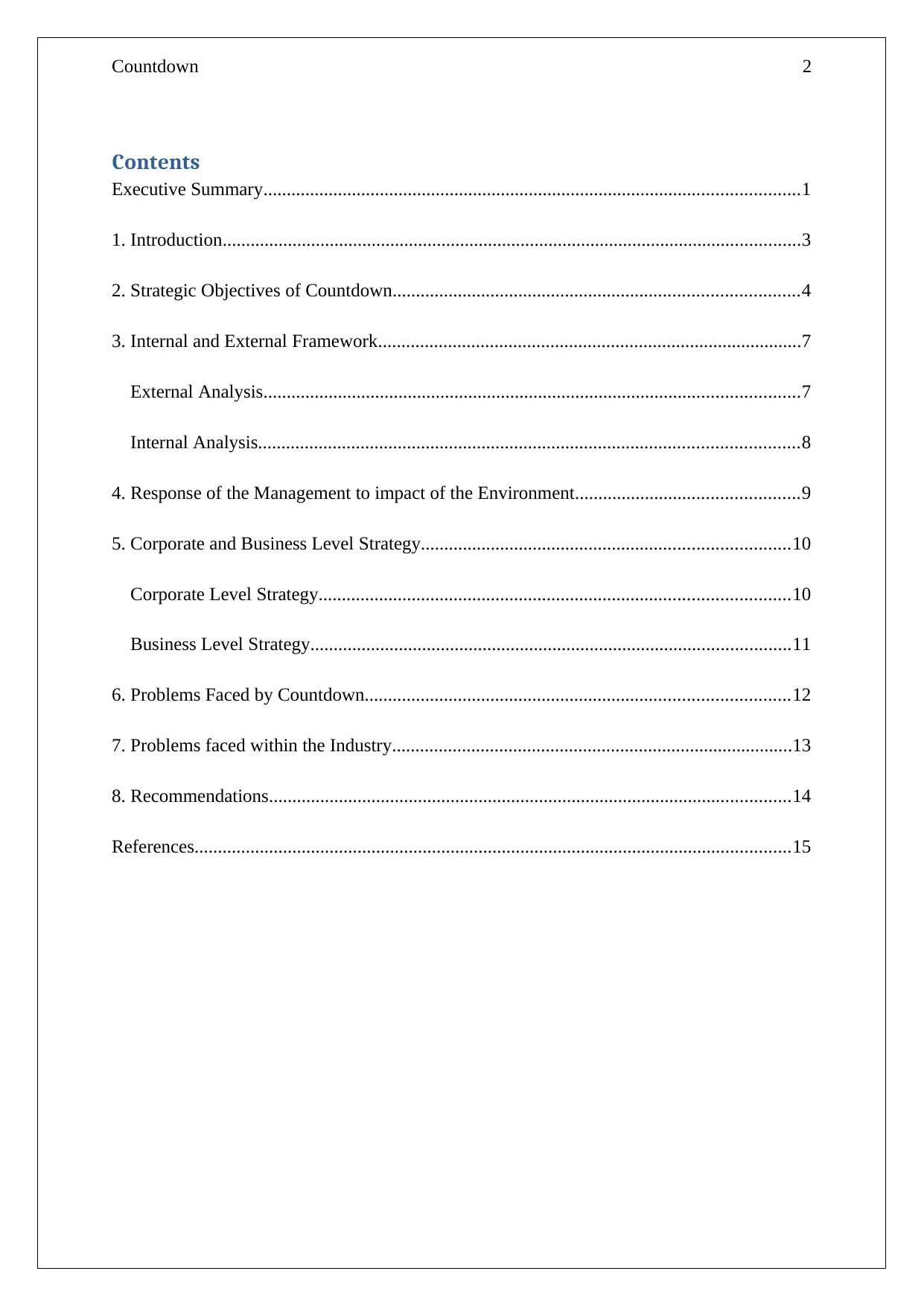
Countdown 2
Contents
Executive Summary...................................................................................................................1
1. Introduction............................................................................................................................3
2. Strategic Objectives of Countdown.......................................................................................4
3. Internal and External Framework...........................................................................................7
External Analysis...................................................................................................................7
Internal Analysis....................................................................................................................8
4. Response of the Management to impact of the Environment................................................9
5. Corporate and Business Level Strategy...............................................................................10
Corporate Level Strategy.....................................................................................................10
Business Level Strategy.......................................................................................................11
6. Problems Faced by Countdown...........................................................................................12
7. Problems faced within the Industry......................................................................................13
8. Recommendations................................................................................................................14
References................................................................................................................................15
Contents
Executive Summary...................................................................................................................1
1. Introduction............................................................................................................................3
2. Strategic Objectives of Countdown.......................................................................................4
3. Internal and External Framework...........................................................................................7
External Analysis...................................................................................................................7
Internal Analysis....................................................................................................................8
4. Response of the Management to impact of the Environment................................................9
5. Corporate and Business Level Strategy...............................................................................10
Corporate Level Strategy.....................................................................................................10
Business Level Strategy.......................................................................................................11
6. Problems Faced by Countdown...........................................................................................12
7. Problems faced within the Industry......................................................................................13
8. Recommendations................................................................................................................14
References................................................................................................................................15
⊘ This is a preview!⊘
Do you want full access?
Subscribe today to unlock all pages.

Trusted by 1+ million students worldwide
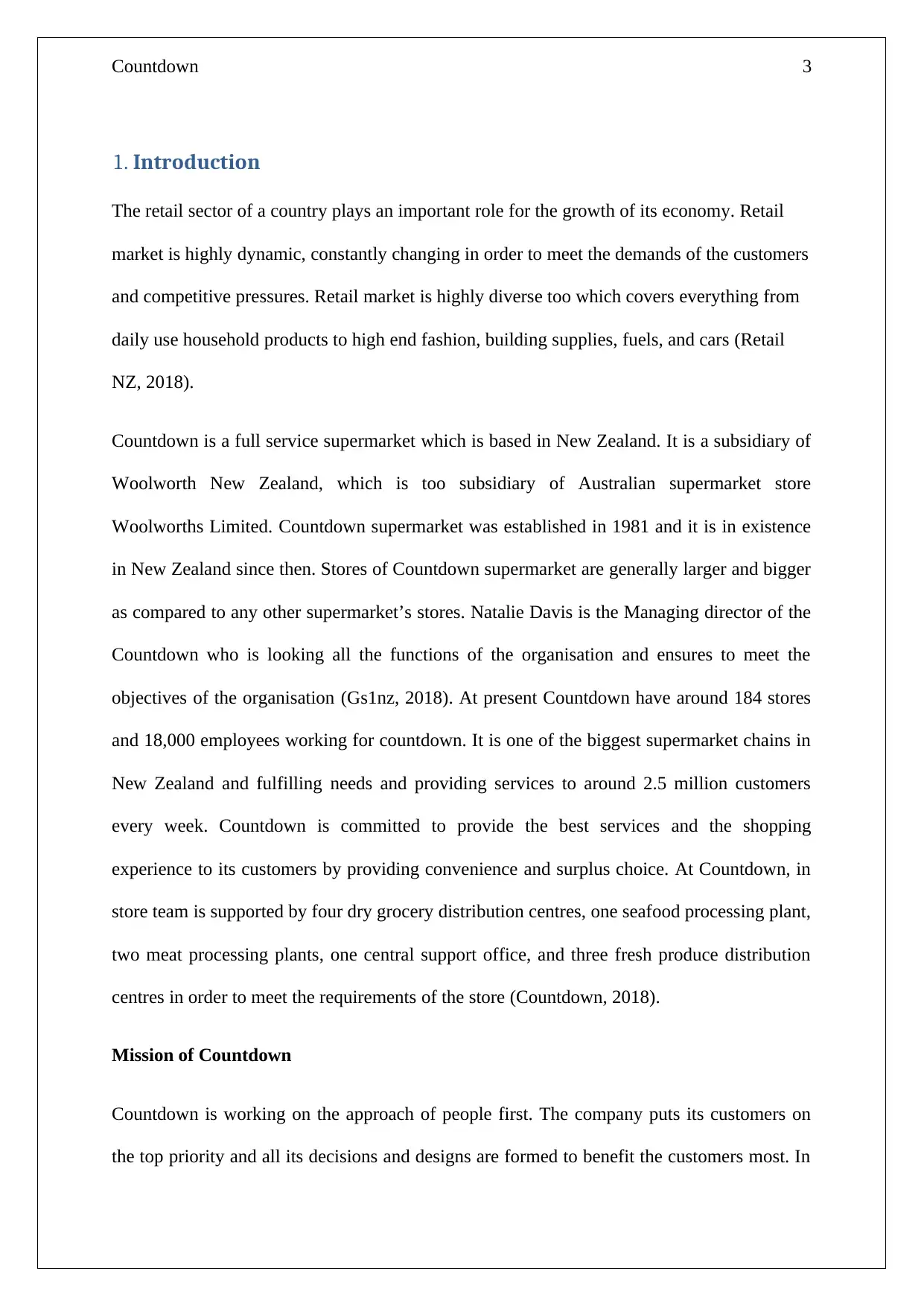
Countdown 3
1. Introduction
The retail sector of a country plays an important role for the growth of its economy. Retail
market is highly dynamic, constantly changing in order to meet the demands of the customers
and competitive pressures. Retail market is highly diverse too which covers everything from
daily use household products to high end fashion, building supplies, fuels, and cars (Retail
NZ, 2018).
Countdown is a full service supermarket which is based in New Zealand. It is a subsidiary of
Woolworth New Zealand, which is too subsidiary of Australian supermarket store
Woolworths Limited. Countdown supermarket was established in 1981 and it is in existence
in New Zealand since then. Stores of Countdown supermarket are generally larger and bigger
as compared to any other supermarket’s stores. Natalie Davis is the Managing director of the
Countdown who is looking all the functions of the organisation and ensures to meet the
objectives of the organisation (Gs1nz, 2018). At present Countdown have around 184 stores
and 18,000 employees working for countdown. It is one of the biggest supermarket chains in
New Zealand and fulfilling needs and providing services to around 2.5 million customers
every week. Countdown is committed to provide the best services and the shopping
experience to its customers by providing convenience and surplus choice. At Countdown, in
store team is supported by four dry grocery distribution centres, one seafood processing plant,
two meat processing plants, one central support office, and three fresh produce distribution
centres in order to meet the requirements of the store (Countdown, 2018).
Mission of Countdown
Countdown is working on the approach of people first. The company puts its customers on
the top priority and all its decisions and designs are formed to benefit the customers most. In
1. Introduction
The retail sector of a country plays an important role for the growth of its economy. Retail
market is highly dynamic, constantly changing in order to meet the demands of the customers
and competitive pressures. Retail market is highly diverse too which covers everything from
daily use household products to high end fashion, building supplies, fuels, and cars (Retail
NZ, 2018).
Countdown is a full service supermarket which is based in New Zealand. It is a subsidiary of
Woolworth New Zealand, which is too subsidiary of Australian supermarket store
Woolworths Limited. Countdown supermarket was established in 1981 and it is in existence
in New Zealand since then. Stores of Countdown supermarket are generally larger and bigger
as compared to any other supermarket’s stores. Natalie Davis is the Managing director of the
Countdown who is looking all the functions of the organisation and ensures to meet the
objectives of the organisation (Gs1nz, 2018). At present Countdown have around 184 stores
and 18,000 employees working for countdown. It is one of the biggest supermarket chains in
New Zealand and fulfilling needs and providing services to around 2.5 million customers
every week. Countdown is committed to provide the best services and the shopping
experience to its customers by providing convenience and surplus choice. At Countdown, in
store team is supported by four dry grocery distribution centres, one seafood processing plant,
two meat processing plants, one central support office, and three fresh produce distribution
centres in order to meet the requirements of the store (Countdown, 2018).
Mission of Countdown
Countdown is working on the approach of people first. The company puts its customers on
the top priority and all its decisions and designs are formed to benefit the customers most. In
Paraphrase This Document
Need a fresh take? Get an instant paraphrase of this document with our AI Paraphraser
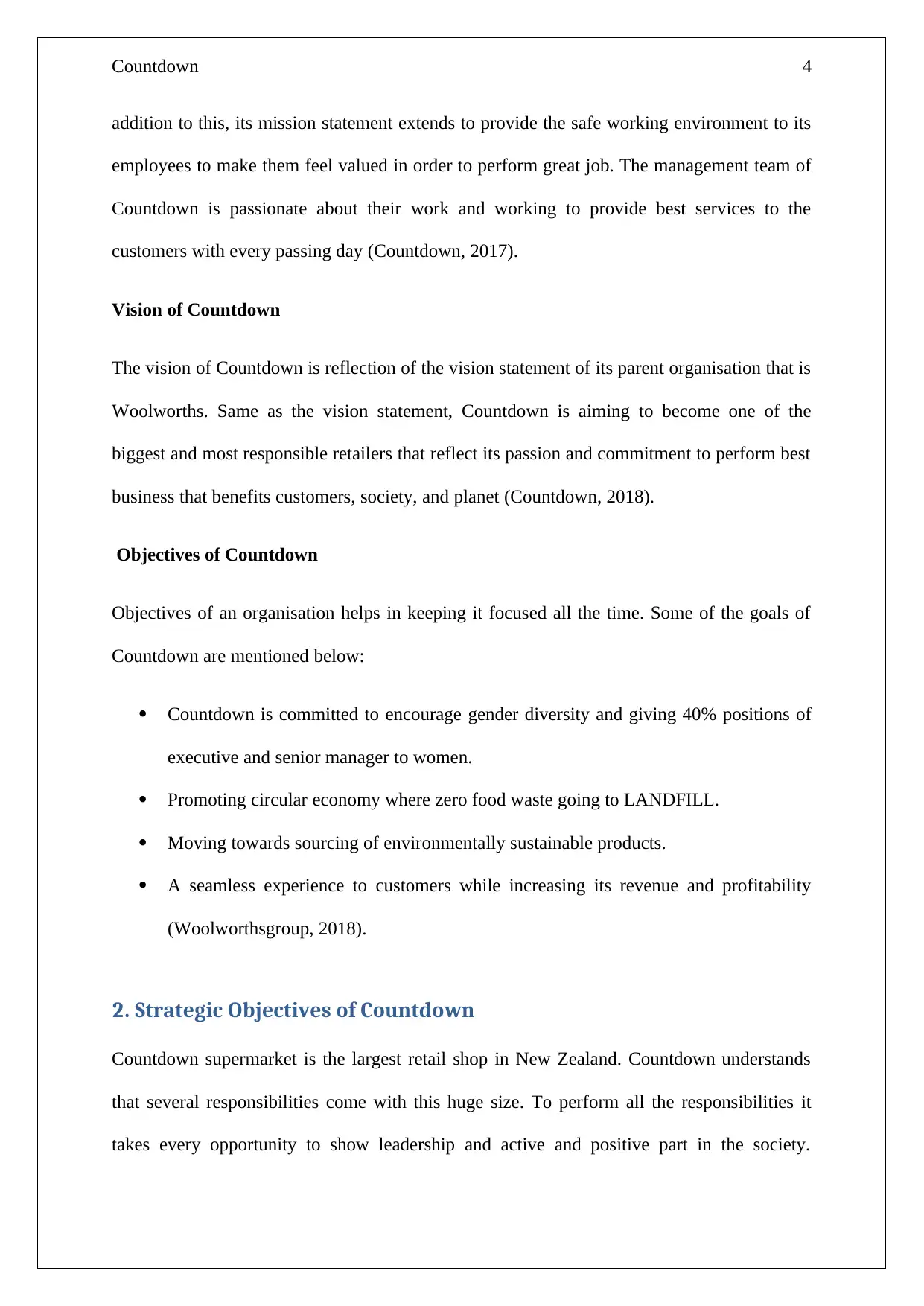
Countdown 4
addition to this, its mission statement extends to provide the safe working environment to its
employees to make them feel valued in order to perform great job. The management team of
Countdown is passionate about their work and working to provide best services to the
customers with every passing day (Countdown, 2017).
Vision of Countdown
The vision of Countdown is reflection of the vision statement of its parent organisation that is
Woolworths. Same as the vision statement, Countdown is aiming to become one of the
biggest and most responsible retailers that reflect its passion and commitment to perform best
business that benefits customers, society, and planet (Countdown, 2018).
Objectives of Countdown
Objectives of an organisation helps in keeping it focused all the time. Some of the goals of
Countdown are mentioned below:
Countdown is committed to encourage gender diversity and giving 40% positions of
executive and senior manager to women.
Promoting circular economy where zero food waste going to LANDFILL.
Moving towards sourcing of environmentally sustainable products.
A seamless experience to customers while increasing its revenue and profitability
(Woolworthsgroup, 2018).
2. Strategic Objectives of Countdown
Countdown supermarket is the largest retail shop in New Zealand. Countdown understands
that several responsibilities come with this huge size. To perform all the responsibilities it
takes every opportunity to show leadership and active and positive part in the society.
addition to this, its mission statement extends to provide the safe working environment to its
employees to make them feel valued in order to perform great job. The management team of
Countdown is passionate about their work and working to provide best services to the
customers with every passing day (Countdown, 2017).
Vision of Countdown
The vision of Countdown is reflection of the vision statement of its parent organisation that is
Woolworths. Same as the vision statement, Countdown is aiming to become one of the
biggest and most responsible retailers that reflect its passion and commitment to perform best
business that benefits customers, society, and planet (Countdown, 2018).
Objectives of Countdown
Objectives of an organisation helps in keeping it focused all the time. Some of the goals of
Countdown are mentioned below:
Countdown is committed to encourage gender diversity and giving 40% positions of
executive and senior manager to women.
Promoting circular economy where zero food waste going to LANDFILL.
Moving towards sourcing of environmentally sustainable products.
A seamless experience to customers while increasing its revenue and profitability
(Woolworthsgroup, 2018).
2. Strategic Objectives of Countdown
Countdown supermarket is the largest retail shop in New Zealand. Countdown understands
that several responsibilities come with this huge size. To perform all the responsibilities it
takes every opportunity to show leadership and active and positive part in the society.
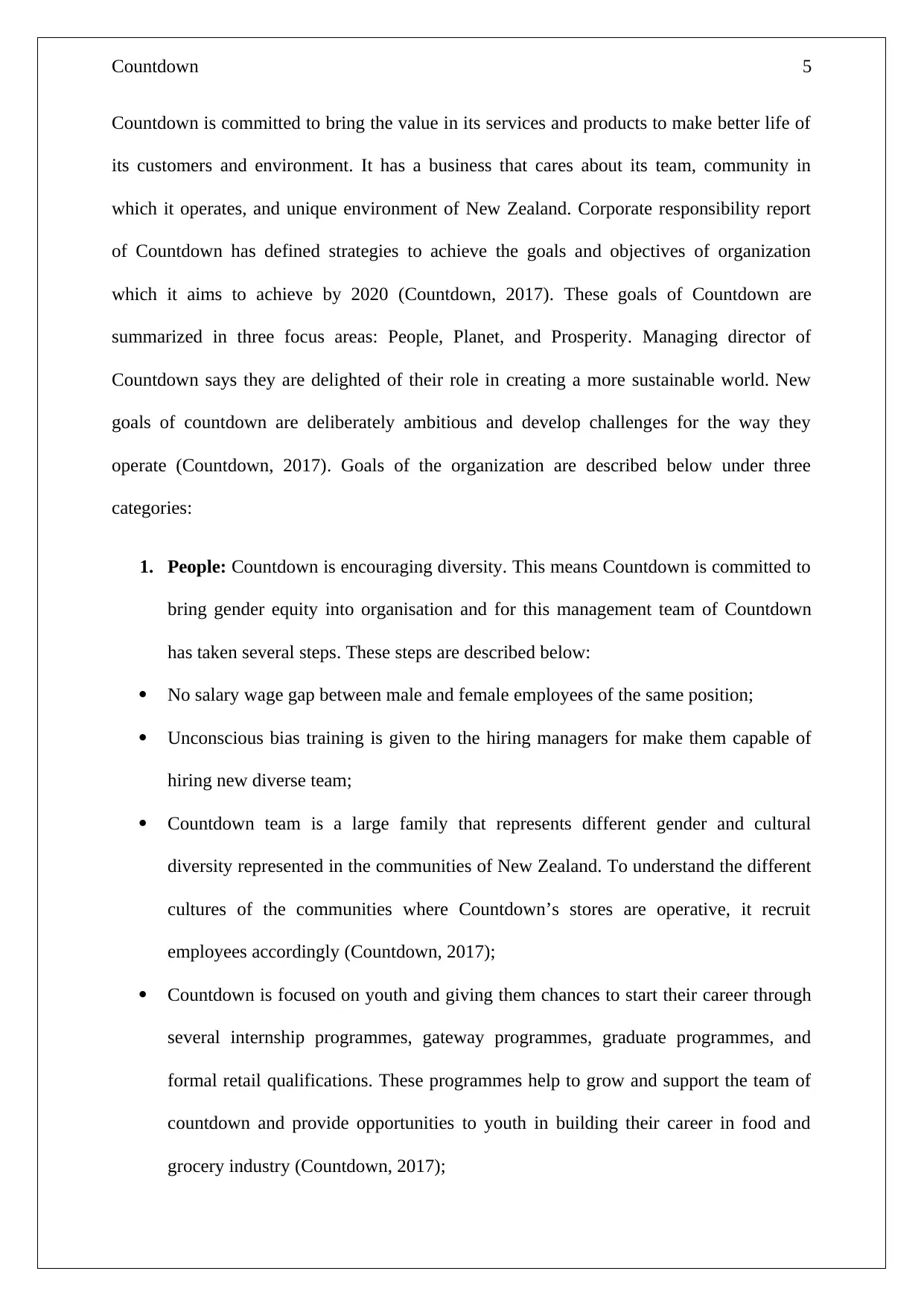
Countdown 5
Countdown is committed to bring the value in its services and products to make better life of
its customers and environment. It has a business that cares about its team, community in
which it operates, and unique environment of New Zealand. Corporate responsibility report
of Countdown has defined strategies to achieve the goals and objectives of organization
which it aims to achieve by 2020 (Countdown, 2017). These goals of Countdown are
summarized in three focus areas: People, Planet, and Prosperity. Managing director of
Countdown says they are delighted of their role in creating a more sustainable world. New
goals of countdown are deliberately ambitious and develop challenges for the way they
operate (Countdown, 2017). Goals of the organization are described below under three
categories:
1. People: Countdown is encouraging diversity. This means Countdown is committed to
bring gender equity into organisation and for this management team of Countdown
has taken several steps. These steps are described below:
No salary wage gap between male and female employees of the same position;
Unconscious bias training is given to the hiring managers for make them capable of
hiring new diverse team;
Countdown team is a large family that represents different gender and cultural
diversity represented in the communities of New Zealand. To understand the different
cultures of the communities where Countdown’s stores are operative, it recruit
employees accordingly (Countdown, 2017);
Countdown is focused on youth and giving them chances to start their career through
several internship programmes, gateway programmes, graduate programmes, and
formal retail qualifications. These programmes help to grow and support the team of
countdown and provide opportunities to youth in building their career in food and
grocery industry (Countdown, 2017);
Countdown is committed to bring the value in its services and products to make better life of
its customers and environment. It has a business that cares about its team, community in
which it operates, and unique environment of New Zealand. Corporate responsibility report
of Countdown has defined strategies to achieve the goals and objectives of organization
which it aims to achieve by 2020 (Countdown, 2017). These goals of Countdown are
summarized in three focus areas: People, Planet, and Prosperity. Managing director of
Countdown says they are delighted of their role in creating a more sustainable world. New
goals of countdown are deliberately ambitious and develop challenges for the way they
operate (Countdown, 2017). Goals of the organization are described below under three
categories:
1. People: Countdown is encouraging diversity. This means Countdown is committed to
bring gender equity into organisation and for this management team of Countdown
has taken several steps. These steps are described below:
No salary wage gap between male and female employees of the same position;
Unconscious bias training is given to the hiring managers for make them capable of
hiring new diverse team;
Countdown team is a large family that represents different gender and cultural
diversity represented in the communities of New Zealand. To understand the different
cultures of the communities where Countdown’s stores are operative, it recruit
employees accordingly (Countdown, 2017);
Countdown is focused on youth and giving them chances to start their career through
several internship programmes, gateway programmes, graduate programmes, and
formal retail qualifications. These programmes help to grow and support the team of
countdown and provide opportunities to youth in building their career in food and
grocery industry (Countdown, 2017);
⊘ This is a preview!⊘
Do you want full access?
Subscribe today to unlock all pages.

Trusted by 1+ million students worldwide
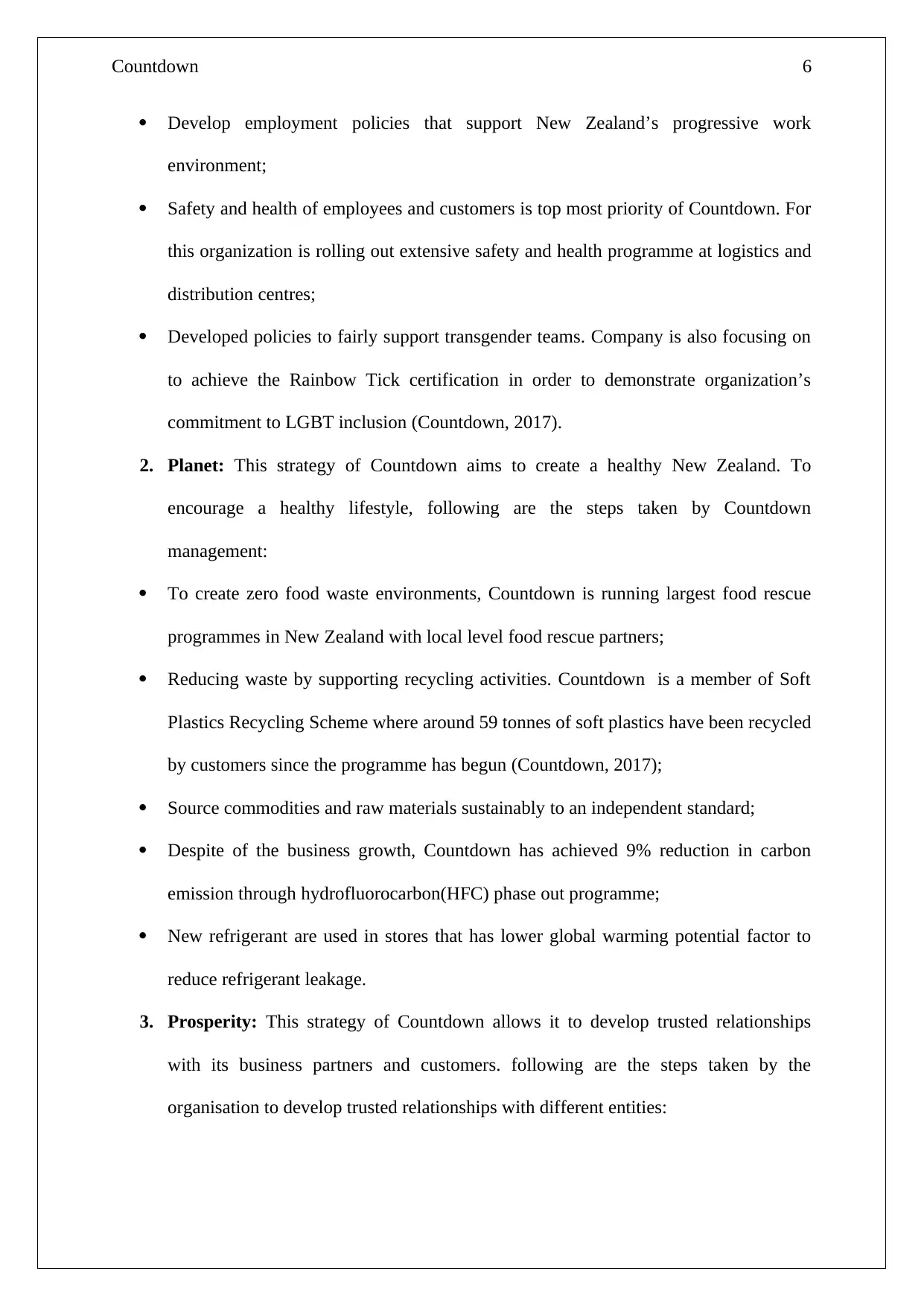
Countdown 6
Develop employment policies that support New Zealand’s progressive work
environment;
Safety and health of employees and customers is top most priority of Countdown. For
this organization is rolling out extensive safety and health programme at logistics and
distribution centres;
Developed policies to fairly support transgender teams. Company is also focusing on
to achieve the Rainbow Tick certification in order to demonstrate organization’s
commitment to LGBT inclusion (Countdown, 2017).
2. Planet: This strategy of Countdown aims to create a healthy New Zealand. To
encourage a healthy lifestyle, following are the steps taken by Countdown
management:
To create zero food waste environments, Countdown is running largest food rescue
programmes in New Zealand with local level food rescue partners;
Reducing waste by supporting recycling activities. Countdown is a member of Soft
Plastics Recycling Scheme where around 59 tonnes of soft plastics have been recycled
by customers since the programme has begun (Countdown, 2017);
Source commodities and raw materials sustainably to an independent standard;
Despite of the business growth, Countdown has achieved 9% reduction in carbon
emission through hydrofluorocarbon(HFC) phase out programme;
New refrigerant are used in stores that has lower global warming potential factor to
reduce refrigerant leakage.
3. Prosperity: This strategy of Countdown allows it to develop trusted relationships
with its business partners and customers. following are the steps taken by the
organisation to develop trusted relationships with different entities:
Develop employment policies that support New Zealand’s progressive work
environment;
Safety and health of employees and customers is top most priority of Countdown. For
this organization is rolling out extensive safety and health programme at logistics and
distribution centres;
Developed policies to fairly support transgender teams. Company is also focusing on
to achieve the Rainbow Tick certification in order to demonstrate organization’s
commitment to LGBT inclusion (Countdown, 2017).
2. Planet: This strategy of Countdown aims to create a healthy New Zealand. To
encourage a healthy lifestyle, following are the steps taken by Countdown
management:
To create zero food waste environments, Countdown is running largest food rescue
programmes in New Zealand with local level food rescue partners;
Reducing waste by supporting recycling activities. Countdown is a member of Soft
Plastics Recycling Scheme where around 59 tonnes of soft plastics have been recycled
by customers since the programme has begun (Countdown, 2017);
Source commodities and raw materials sustainably to an independent standard;
Despite of the business growth, Countdown has achieved 9% reduction in carbon
emission through hydrofluorocarbon(HFC) phase out programme;
New refrigerant are used in stores that has lower global warming potential factor to
reduce refrigerant leakage.
3. Prosperity: This strategy of Countdown allows it to develop trusted relationships
with its business partners and customers. following are the steps taken by the
organisation to develop trusted relationships with different entities:
Paraphrase This Document
Need a fresh take? Get an instant paraphrase of this document with our AI Paraphraser

Countdown 7
Countdown is aiming at achieving top quartile favourability ranking with its
suppliers;
Countdown will focus on the best practice compliance system to develop
collaboration with best organisations in order to advance lives of workers;
Countdown will invest some part of its earnings into the community programmes and
partnerships;
Countdown will support its customers in making healthier and better choices.
3. Internal and External Framework
External Analysis
In this section, profitability or attractiveness of Countdown supermarket in current times is
assessed. To conduct the analysis of external factors, Porter’s Five Forces Analysis is used.
Threat of Substitutes: There are many indirect competitors in market; therefore, threat of
substitutes is high for Countdown. These indirect competitors are specialist stores,
convenience markets, and farmers’ markets. Evidence shows serious threats from these
indirect competitors for Countdown in future. Addition to these convenience stores now also
offering expansion in product that is creating competition for supermarkets in terms of choice
and convenience. Organic products sold by farmer’s market are another threat for Countdown
(Hill & Jones, 2009).
Threat of New Entrants: At present threat of new entrants is less and this seems unchanged
for a long period of time. This is because of insidious leasing agreements with landlords and
local zoning laws have resulted in decrease in grocery store sites. Therefore, this has blocked
the entrants of new grocery stores in the market, especially for overseas organizations that
want to make an entry in New Zealand grocery industry. Further it is not easy for potential
Countdown is aiming at achieving top quartile favourability ranking with its
suppliers;
Countdown will focus on the best practice compliance system to develop
collaboration with best organisations in order to advance lives of workers;
Countdown will invest some part of its earnings into the community programmes and
partnerships;
Countdown will support its customers in making healthier and better choices.
3. Internal and External Framework
External Analysis
In this section, profitability or attractiveness of Countdown supermarket in current times is
assessed. To conduct the analysis of external factors, Porter’s Five Forces Analysis is used.
Threat of Substitutes: There are many indirect competitors in market; therefore, threat of
substitutes is high for Countdown. These indirect competitors are specialist stores,
convenience markets, and farmers’ markets. Evidence shows serious threats from these
indirect competitors for Countdown in future. Addition to these convenience stores now also
offering expansion in product that is creating competition for supermarkets in terms of choice
and convenience. Organic products sold by farmer’s market are another threat for Countdown
(Hill & Jones, 2009).
Threat of New Entrants: At present threat of new entrants is less and this seems unchanged
for a long period of time. This is because of insidious leasing agreements with landlords and
local zoning laws have resulted in decrease in grocery store sites. Therefore, this has blocked
the entrants of new grocery stores in the market, especially for overseas organizations that
want to make an entry in New Zealand grocery industry. Further it is not easy for potential
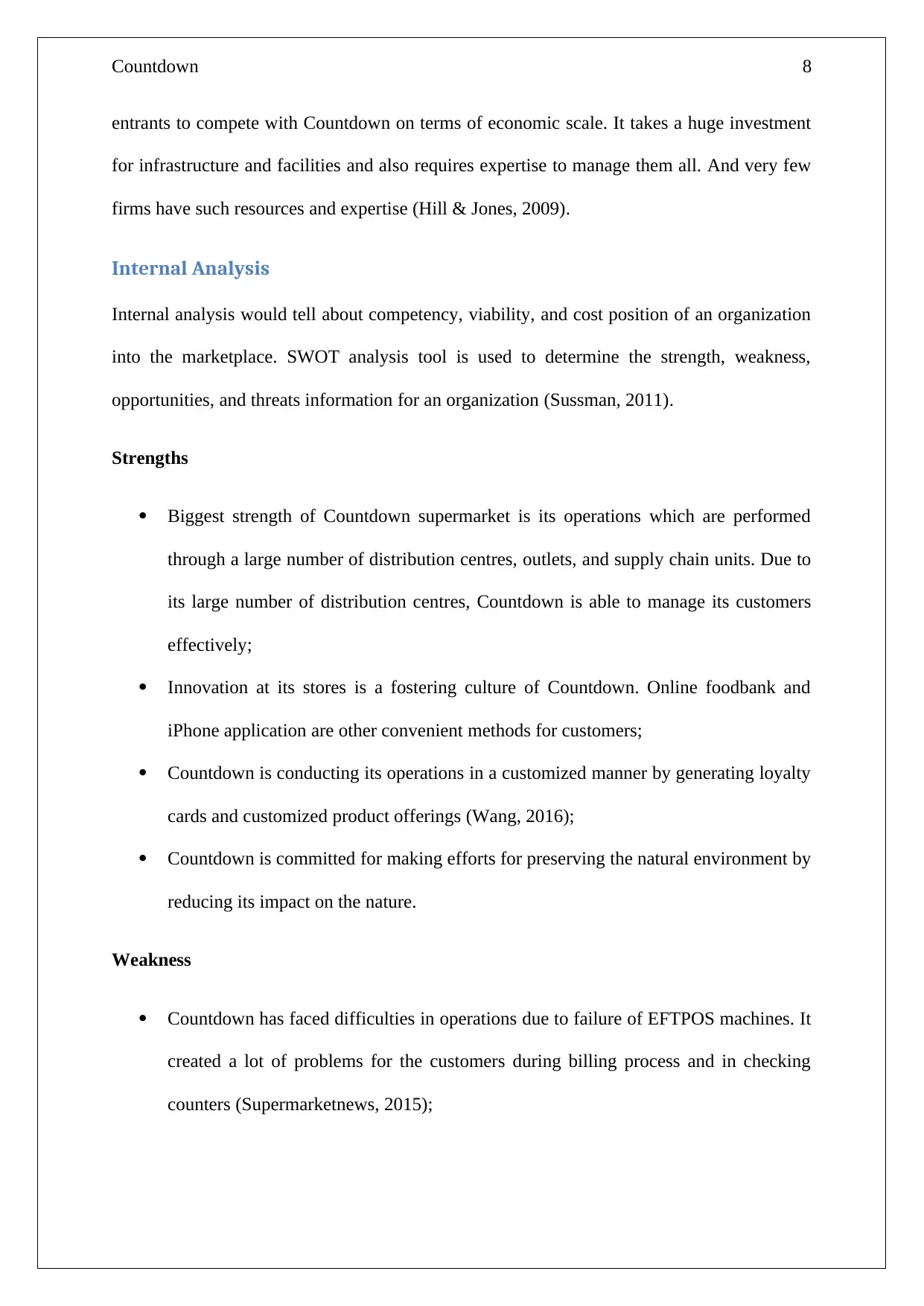
Countdown 8
entrants to compete with Countdown on terms of economic scale. It takes a huge investment
for infrastructure and facilities and also requires expertise to manage them all. And very few
firms have such resources and expertise (Hill & Jones, 2009).
Internal Analysis
Internal analysis would tell about competency, viability, and cost position of an organization
into the marketplace. SWOT analysis tool is used to determine the strength, weakness,
opportunities, and threats information for an organization (Sussman, 2011).
Strengths
Biggest strength of Countdown supermarket is its operations which are performed
through a large number of distribution centres, outlets, and supply chain units. Due to
its large number of distribution centres, Countdown is able to manage its customers
effectively;
Innovation at its stores is a fostering culture of Countdown. Online foodbank and
iPhone application are other convenient methods for customers;
Countdown is conducting its operations in a customized manner by generating loyalty
cards and customized product offerings (Wang, 2016);
Countdown is committed for making efforts for preserving the natural environment by
reducing its impact on the nature.
Weakness
Countdown has faced difficulties in operations due to failure of EFTPOS machines. It
created a lot of problems for the customers during billing process and in checking
counters (Supermarketnews, 2015);
entrants to compete with Countdown on terms of economic scale. It takes a huge investment
for infrastructure and facilities and also requires expertise to manage them all. And very few
firms have such resources and expertise (Hill & Jones, 2009).
Internal Analysis
Internal analysis would tell about competency, viability, and cost position of an organization
into the marketplace. SWOT analysis tool is used to determine the strength, weakness,
opportunities, and threats information for an organization (Sussman, 2011).
Strengths
Biggest strength of Countdown supermarket is its operations which are performed
through a large number of distribution centres, outlets, and supply chain units. Due to
its large number of distribution centres, Countdown is able to manage its customers
effectively;
Innovation at its stores is a fostering culture of Countdown. Online foodbank and
iPhone application are other convenient methods for customers;
Countdown is conducting its operations in a customized manner by generating loyalty
cards and customized product offerings (Wang, 2016);
Countdown is committed for making efforts for preserving the natural environment by
reducing its impact on the nature.
Weakness
Countdown has faced difficulties in operations due to failure of EFTPOS machines. It
created a lot of problems for the customers during billing process and in checking
counters (Supermarketnews, 2015);
⊘ This is a preview!⊘
Do you want full access?
Subscribe today to unlock all pages.

Trusted by 1+ million students worldwide
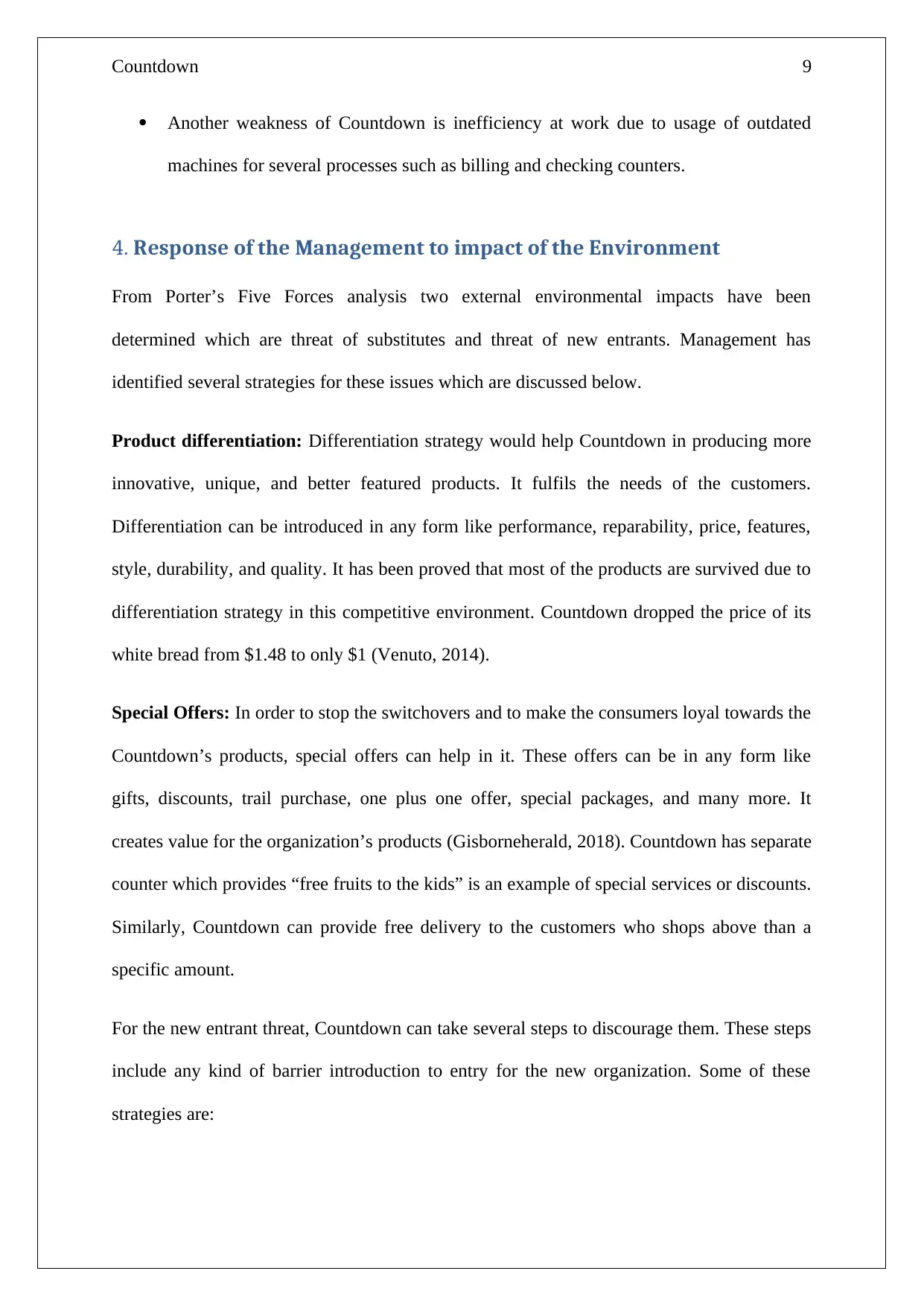
Countdown 9
Another weakness of Countdown is inefficiency at work due to usage of outdated
machines for several processes such as billing and checking counters.
4. Response of the Management to impact of the Environment
From Porter’s Five Forces analysis two external environmental impacts have been
determined which are threat of substitutes and threat of new entrants. Management has
identified several strategies for these issues which are discussed below.
Product differentiation: Differentiation strategy would help Countdown in producing more
innovative, unique, and better featured products. It fulfils the needs of the customers.
Differentiation can be introduced in any form like performance, reparability, price, features,
style, durability, and quality. It has been proved that most of the products are survived due to
differentiation strategy in this competitive environment. Countdown dropped the price of its
white bread from $1.48 to only $1 (Venuto, 2014).
Special Offers: In order to stop the switchovers and to make the consumers loyal towards the
Countdown’s products, special offers can help in it. These offers can be in any form like
gifts, discounts, trail purchase, one plus one offer, special packages, and many more. It
creates value for the organization’s products (Gisborneherald, 2018). Countdown has separate
counter which provides “free fruits to the kids” is an example of special services or discounts.
Similarly, Countdown can provide free delivery to the customers who shops above than a
specific amount.
For the new entrant threat, Countdown can take several steps to discourage them. These steps
include any kind of barrier introduction to entry for the new organization. Some of these
strategies are:
Another weakness of Countdown is inefficiency at work due to usage of outdated
machines for several processes such as billing and checking counters.
4. Response of the Management to impact of the Environment
From Porter’s Five Forces analysis two external environmental impacts have been
determined which are threat of substitutes and threat of new entrants. Management has
identified several strategies for these issues which are discussed below.
Product differentiation: Differentiation strategy would help Countdown in producing more
innovative, unique, and better featured products. It fulfils the needs of the customers.
Differentiation can be introduced in any form like performance, reparability, price, features,
style, durability, and quality. It has been proved that most of the products are survived due to
differentiation strategy in this competitive environment. Countdown dropped the price of its
white bread from $1.48 to only $1 (Venuto, 2014).
Special Offers: In order to stop the switchovers and to make the consumers loyal towards the
Countdown’s products, special offers can help in it. These offers can be in any form like
gifts, discounts, trail purchase, one plus one offer, special packages, and many more. It
creates value for the organization’s products (Gisborneherald, 2018). Countdown has separate
counter which provides “free fruits to the kids” is an example of special services or discounts.
Similarly, Countdown can provide free delivery to the customers who shops above than a
specific amount.
For the new entrant threat, Countdown can take several steps to discourage them. These steps
include any kind of barrier introduction to entry for the new organization. Some of these
strategies are:
Paraphrase This Document
Need a fresh take? Get an instant paraphrase of this document with our AI Paraphraser
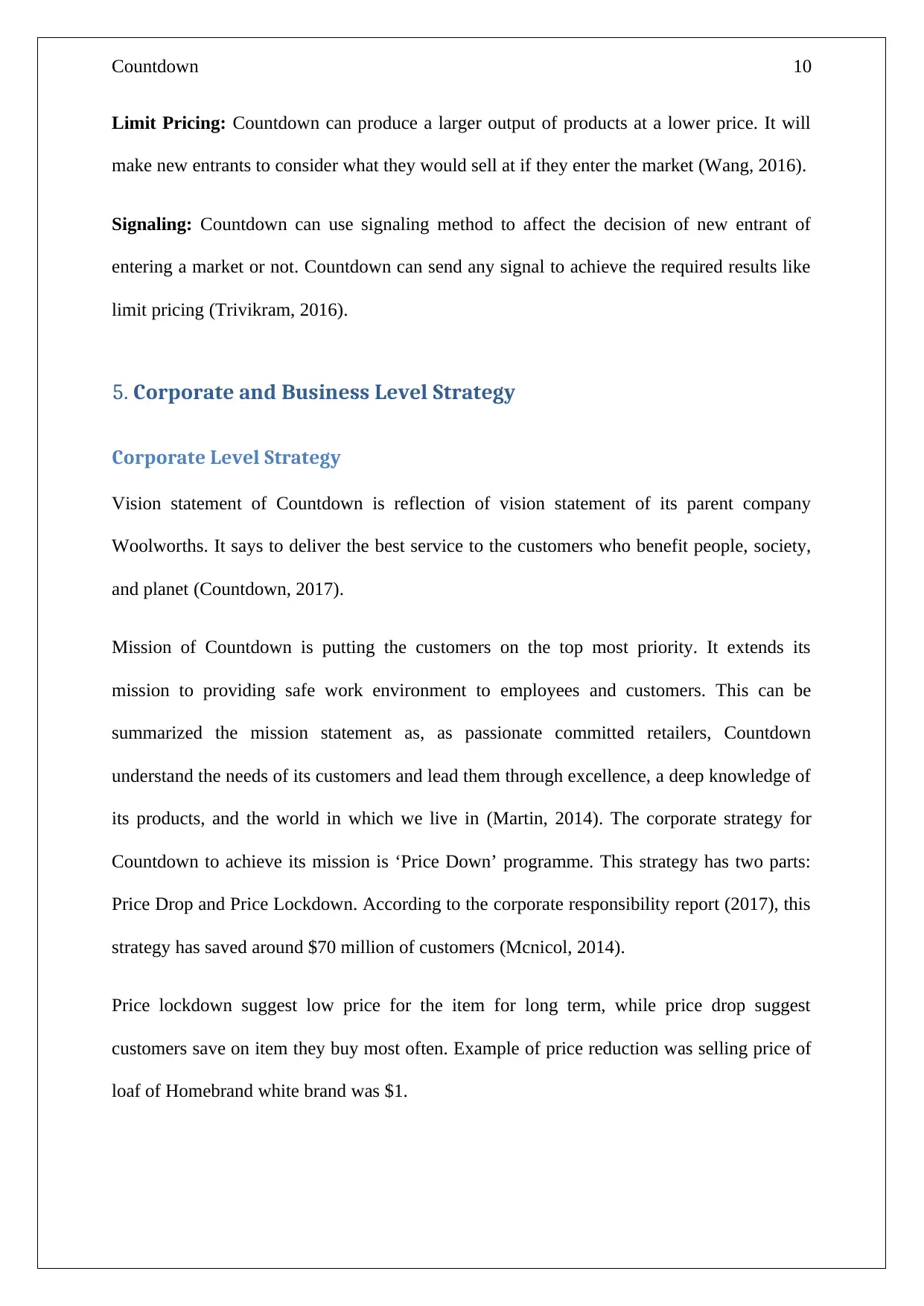
Countdown 10
Limit Pricing: Countdown can produce a larger output of products at a lower price. It will
make new entrants to consider what they would sell at if they enter the market (Wang, 2016).
Signaling: Countdown can use signaling method to affect the decision of new entrant of
entering a market or not. Countdown can send any signal to achieve the required results like
limit pricing (Trivikram, 2016).
5. Corporate and Business Level Strategy
Corporate Level Strategy
Vision statement of Countdown is reflection of vision statement of its parent company
Woolworths. It says to deliver the best service to the customers who benefit people, society,
and planet (Countdown, 2017).
Mission of Countdown is putting the customers on the top most priority. It extends its
mission to providing safe work environment to employees and customers. This can be
summarized the mission statement as, as passionate committed retailers, Countdown
understand the needs of its customers and lead them through excellence, a deep knowledge of
its products, and the world in which we live in (Martin, 2014). The corporate strategy for
Countdown to achieve its mission is ‘Price Down’ programme. This strategy has two parts:
Price Drop and Price Lockdown. According to the corporate responsibility report (2017), this
strategy has saved around $70 million of customers (Mcnicol, 2014).
Price lockdown suggest low price for the item for long term, while price drop suggest
customers save on item they buy most often. Example of price reduction was selling price of
loaf of Homebrand white brand was $1.
Limit Pricing: Countdown can produce a larger output of products at a lower price. It will
make new entrants to consider what they would sell at if they enter the market (Wang, 2016).
Signaling: Countdown can use signaling method to affect the decision of new entrant of
entering a market or not. Countdown can send any signal to achieve the required results like
limit pricing (Trivikram, 2016).
5. Corporate and Business Level Strategy
Corporate Level Strategy
Vision statement of Countdown is reflection of vision statement of its parent company
Woolworths. It says to deliver the best service to the customers who benefit people, society,
and planet (Countdown, 2017).
Mission of Countdown is putting the customers on the top most priority. It extends its
mission to providing safe work environment to employees and customers. This can be
summarized the mission statement as, as passionate committed retailers, Countdown
understand the needs of its customers and lead them through excellence, a deep knowledge of
its products, and the world in which we live in (Martin, 2014). The corporate strategy for
Countdown to achieve its mission is ‘Price Down’ programme. This strategy has two parts:
Price Drop and Price Lockdown. According to the corporate responsibility report (2017), this
strategy has saved around $70 million of customers (Mcnicol, 2014).
Price lockdown suggest low price for the item for long term, while price drop suggest
customers save on item they buy most often. Example of price reduction was selling price of
loaf of Homebrand white brand was $1.
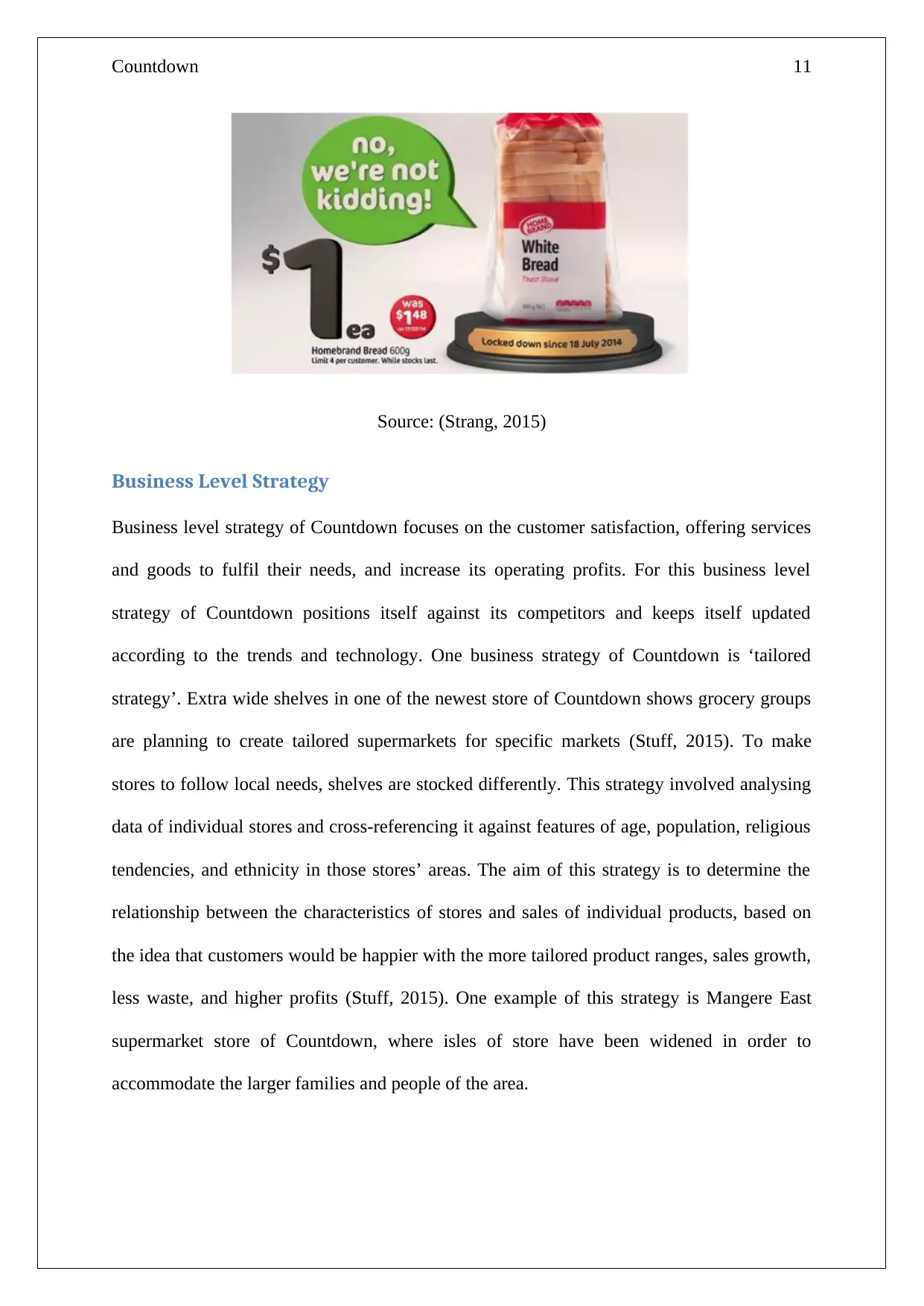
Countdown 11
Source: (Strang, 2015)
Business Level Strategy
Business level strategy of Countdown focuses on the customer satisfaction, offering services
and goods to fulfil their needs, and increase its operating profits. For this business level
strategy of Countdown positions itself against its competitors and keeps itself updated
according to the trends and technology. One business strategy of Countdown is ‘tailored
strategy’. Extra wide shelves in one of the newest store of Countdown shows grocery groups
are planning to create tailored supermarkets for specific markets (Stuff, 2015). To make
stores to follow local needs, shelves are stocked differently. This strategy involved analysing
data of individual stores and cross-referencing it against features of age, population, religious
tendencies, and ethnicity in those stores’ areas. The aim of this strategy is to determine the
relationship between the characteristics of stores and sales of individual products, based on
the idea that customers would be happier with the more tailored product ranges, sales growth,
less waste, and higher profits (Stuff, 2015). One example of this strategy is Mangere East
supermarket store of Countdown, where isles of store have been widened in order to
accommodate the larger families and people of the area.
Source: (Strang, 2015)
Business Level Strategy
Business level strategy of Countdown focuses on the customer satisfaction, offering services
and goods to fulfil their needs, and increase its operating profits. For this business level
strategy of Countdown positions itself against its competitors and keeps itself updated
according to the trends and technology. One business strategy of Countdown is ‘tailored
strategy’. Extra wide shelves in one of the newest store of Countdown shows grocery groups
are planning to create tailored supermarkets for specific markets (Stuff, 2015). To make
stores to follow local needs, shelves are stocked differently. This strategy involved analysing
data of individual stores and cross-referencing it against features of age, population, religious
tendencies, and ethnicity in those stores’ areas. The aim of this strategy is to determine the
relationship between the characteristics of stores and sales of individual products, based on
the idea that customers would be happier with the more tailored product ranges, sales growth,
less waste, and higher profits (Stuff, 2015). One example of this strategy is Mangere East
supermarket store of Countdown, where isles of store have been widened in order to
accommodate the larger families and people of the area.
⊘ This is a preview!⊘
Do you want full access?
Subscribe today to unlock all pages.

Trusted by 1+ million students worldwide
1 out of 18
Related Documents
Your All-in-One AI-Powered Toolkit for Academic Success.
+13062052269
info@desklib.com
Available 24*7 on WhatsApp / Email
![[object Object]](/_next/static/media/star-bottom.7253800d.svg)
Unlock your academic potential
Copyright © 2020–2025 A2Z Services. All Rights Reserved. Developed and managed by ZUCOL.



